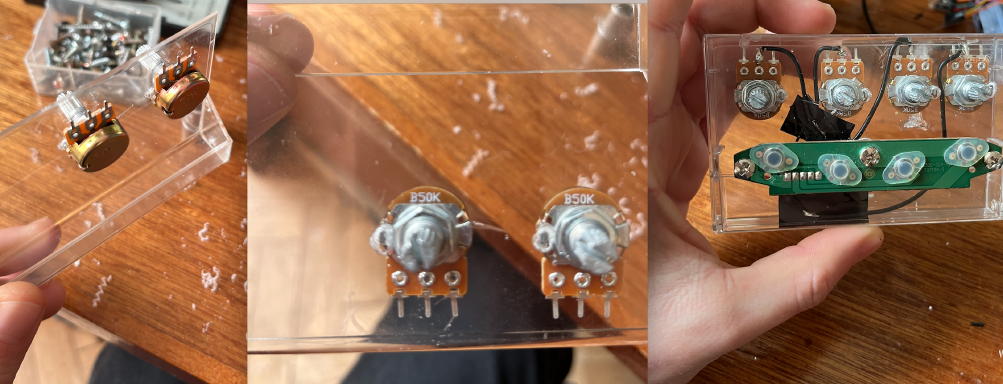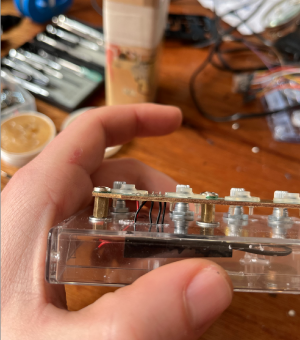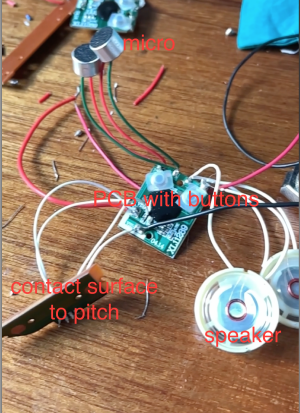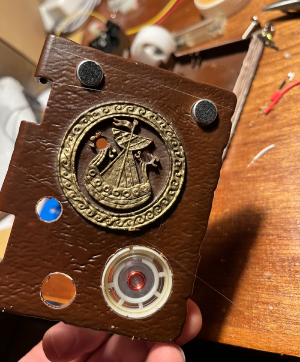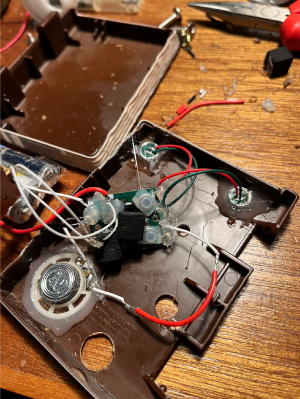No edit summary |
(final) |
||
| Line 28: | Line 28: | ||
Now I was able to play back the cassette at different speeds (pitch it up and down) and also change the pitch while playing. | Now I was able to play back the cassette at different speeds (pitch it up and down) and also change the pitch while playing. | ||
Revision as of 19:37, 14 February 2024
Tired Machines Orchestra
For the Tired Machines Orchestra course, I was building two instruments out of old electronics, that someone else considered to be trash.
I found them at the recycling facility where we picked up the tired machines that still worked fine (most of them)
The Pitchman
The Pitchman was built out of an old Panasonic Walkman that still worked fine, when it fell into my hands and it still does, but now it has some extra features.
According to the speed, of the spinning motor inside cassette player, you are able to change the Pitch of whatever sound is recorded on the cassette.
I did some research on this and found out, that there is a small potentiometer where they set the speed at the factory to make the player spin at the right speed.
I opened the player and found the potentiometer and soldered it out. Next step was, to put a different one with a bigger range to the outside of the player to make it accessible while playing.
The slightly thicker cables in black, blue and green were soldered to the electrical contacts where the old factory potentiometer was sitting.
Now I was able to play back the cassette at different speeds (pitch it up and down) and also change the pitch while playing.
with the potentiometer, you can change the resistance and so the speed (Pitch)
Version 2.0
So I came up with the idea to have several potentiometers and some trigger buttons so set particular resistances (Speeds->Pitches) and trigger them with a button.
I found a circuit to accomplish this.
I used only four buttons and potentiometers and did the wiring the same way as shown in the picture to the left, if you click on the picture, you'll see a bigger version and also the tiny descriptions become more visible.
For my version, I made some kind of handheld thing with all the buttons and potentiometers inside a transparent cassette case.
The buttons were sourced from an old children's toy that I also found at the recycling facility, the potentiometers were ordered in a set online with different values.
At the end, i was able to set different speeds with the potentiometers and trigger them with the four buttons.
TAPES:
I used a tape with recordings of bird voices that sounded very weird but still like birds but different species
if you pitch them up and down and i also used a tape loop with only one Synth sine wave on it that I was able to pitch up and down to a specific tone with the help of a guitar tuner.
If you use two buttons, the values are added to each other and you can play some kind of portamento.
The book of repetitions
For the book of repetitions, I sourced a small PCB of an old children's toy that was used to record and play back ca. 10 sec of sound controlled by two buttons, one to record as long as you hold it down and one to play back the recording function used also a beep sound to indicate start and end of the recording.
To make it more fun, I used a technique called circuit bending. and did some research on this.
I found out, that this small PCBs of children's toys, with the ability of playing back sounds (also if they are fixed and not changeable), are using some kind of oscillator as a reference for the playback speed. You'll find it under the black dot on the PCB. I poked around with some wires and soon found the right spot to install a bend. I connected a small resistor next to the playback circuit to "high" (positive pole) and it resulted in faster playback. I couldn't find a bend to make it slower but I found a other way to pitch down (slow down), wich I'll explain later. *
Since the hard "wired connection" is only able to make the playback very fast or normal (if not connected), I needed to find a way to get different resistances and one common way to do so is, to simply touch the contacts with your finger. Moving and pressing changes the resistance and also the current that is flowing and at the end the speed of playback and so the pitch. I extended the wires of the bend I found and connected them to a rubber pushbutton where i removed the coating from and scratched the PCB so the copper contact was exposed to touch.
At the end, I putted the bended circuit in a happy meal plastic book and installed all the necessary components in the book casing. I also added two screws to be able to push the buttons from outside, when the book case is closed.
The most important modification was also to add a 3.5mm headphone jack to the toy/instrument/machine and a small Potentiometer as a Volume control, when its hooked up to a amplifier or if you use it with headphones, its the small yellow thing.
*If you record something in the pitched up state, with your finger pressed on the open contacts and then remove them, it will be pitched down.
If you make a recording and keep the play button pushed down, it will loop the playback.
sometimes its also distorting the sound and there are happy accidents happening sometimes. ;)



